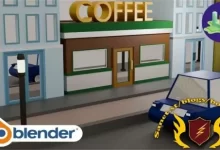Arduino Nano温控继电器学习项目视频教程
这是一个有趣的项目,可以学习如何使用Arduino Nano,并构建您自己的可调温度监控和控制设备。
你将学到什么:
- 在项目中使用Arduino Nano来显示和调整低温和高温限制,并自动激活继电器。
- 学习如何使用DS18B20防水温度传感器、TM1637 7段4位LED显示器、旋转编码器等。
- 学会使用单个瞬时按键来通过区分“短按”和“长按”来控制多个项目。
- Arduino Nano的基础课程,Arduino集成开发环境(IDE)以及初学者的C++基础课程。
- 学会使用Arduino EEPROM库来存储和重新加载重要信息,即使在停电后也能保持。
- 使用可下载的钻孔模板和标签,在项目盒中建立一个外观专业的自动化温控继电器单元。
要求:
- 对电子学有基本的了解。
- 一台计算机以及基本的计算机技能。
- 一些基本的电子零件(在第3讲中涵盖)。
- 无需付费软件 – Arduino IDE和所有所需的源代码都是免费下载的。
描述:
在这门课程中,您不仅会学习Arduino Nano,还将学习如何构建一个完全自动化且用户可调的温控继电器。在课程结束时,您将构建和编程您自己的可调温控继电器,并学到许多关于Arduino Nano微控制器的新知识,以及如何使用DS18B20防水温度传感器、TM1637 7段4位LED显示器、旋转编码器等。如果您是一个绝对的初学者,课程还包括Arduino Nano的介绍模块、如何安装IDE(集成开发环境)软件,以及对C++的基础回顾,以帮助初学者。我们将简化您的学习体验,提供所有源代码,并使您能够按步骤跟随说明,解释每行源代码。我们还将鼓励并指导您参考一些课程外的资源和练习,以熟悉一些所需的工具,很快,您将对基础知识有很好的理解。对于这种类型的设备有如此多的现实应用,这足以使我们创建这门课程。无论您是想要保持某个容器的液体温度在某些值之间,还是想要冷却一些过热的东西,这个实用项目都将帮助您实现这一目标。我们还向您展示如何在LED显示器上滚动显示警告消息,当发生某种预定义条件时,以及如何使用外部电源供应建立更加永久和便携的温控继电器版本。因此,我们希望您决定加入我们,共同踏上这个激动人心的学习之旅,我会在下一讲见到您。
Arduino Nano Thermostatic Relay Learning Project

Published 4/2024
Created by Richard Inniss
MP4 | Video: h264, 1280×720 | Audio: AAC, 44.1 KHz, 2 Ch
Genre: eLearning | Language: English | Duration: 31 Lectures ( 3h 19m ) | Size: 4 GB
A fun project to learn the Arduino Nano and how to build your own Adjustable Temperature Monitoring and Control Device
What you’ll learn:
You’ll learn how to use the Arduino Nano in the context of a project to display and adjust both LOW & HIGH temperature limits and automatically actuate a RELAY.
Learn how to use a DS18B20 Waterproof Temperature Sensor, the TM1637 7-Segment 4-digit LED Display, the rotary encoder and much more.
Learn how to use a single Momentary Push Button to control multiple items by discerning between a “SHORT PRESS” and a “LONG PRESS”.
Basic refresher courses on the Arduino Nano, the Arduino IDE (IDE) or Integrated Development Environment as well as C++ for beginners.
Learn how to use the Arduino EEPROM library to store and reload important information even after power outages.
Build a professional looking Automated Thermostatic Relay unit enclosed in a project box using downloadable drill hole templates and labels.
Requirements:
A basic understanding of electronics
A computer along with basic computer skills
Some basic electronic parts are required (covered in lecture 3)
No paid software required – the Arduino IDE and all required code are free to downloads
Description:
In this course, you’ll not only learn about the Arduino Nano, you’ll also learn how to build a fully automated and user Adjustable Thermostatic Relay. At the end of this course, you’ll have built and programmed your very own Adjustable Thermostatic Relay and learned many new things about the Arduino Nano microcontroller, how to use a DS18B20 Waterproof Temperature Sensor, the TM1637 7-Segment 4-digit LED Display, the rotary encoder and so much moreIf you are an absolute beginner, the course also includes introduction modules on the Arduino Nano, how to install the IDE (Integrated Development Environment) software, as well as a basic refresher on C++ to help the beginner level students. We will simplify your learning experience as we supply all the code and make it easy for you to follow step-by-step instructions, as we explain each line of the code. We’ll also encourage and point you to some resources and exercises outside the course to familiarize yourself with some of the required tools, and in no time, you will have a good understanding of the basics.The fact that their are so many real world applications for this type of a device is compelling enough for us to have created this course. Whether you’re looking for a way to keep the liquid temperature of some container between certain values, or want to cool something which is getting to hot, this practical project will help you achieve this.We also show you how to display a warning message which will scroll on your LED display when a certain predefined condition occurs as well help guide you in building a more permanent and portable version of the Thermostatic Relay using an external power supply.So, we hope you decide to join us on this exciting learning adventure, and I’ll see you in the next lecture.
扫码免费下载








![[WIN]Luminar Neo 图像编辑软件绿色便携版-红杏破解](http://redsex.oh4k.com/wp-content/uploads/2023/07/8b1803931e38f27-220x150.webp)
![[WIN]R-Wipe & Clean 个人隐私清理工具-红杏破解](http://redsex.oh4k.com/wp-content/uploads/2023/08/48a3c1531b2e276-220x150.webp)
![[WIN]Secret Disk Professional 磁盘加密软件破解版-红杏破解](http://redsex.oh4k.com/wp-content/uploads/2023/08/0f6849cd5ee30dc-220x150.webp)
![[WIN]SoftPerfect NetWorx 网络流量带宽检测软件-多语言-红杏破解](http://redsex.oh4k.com/wp-content/uploads/2023/08/e0bef5c2912ec86-220x150.webp)
![[WIN]SkinFiner 智能美白磨皮神器+插件-红杏破解](http://redsex.oh4k.com/wp-content/uploads/2023/08/c3fd57013265f89-220x150.webp)
![[WIN]CyberLink PowerDirector Ultimate威力导演中文破解版-红杏破解](http://redsex.oh4k.com/wp-content/uploads/2023/08/18698d07f327bd9-220x150.webp)